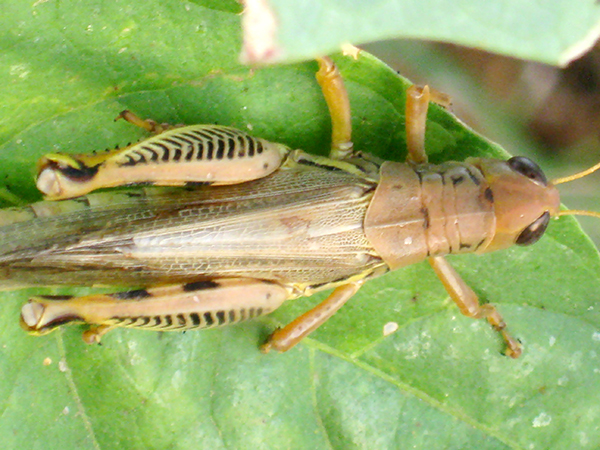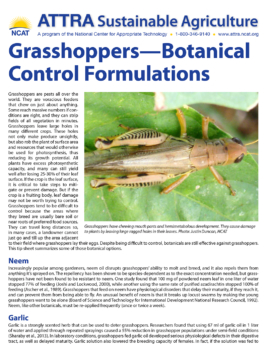Grasshoppers – Botanical Control Formulations

Grasshoppers have chewing mouth parts and hemimetabolous development. They cause damage to plants by leaving large ragged holes in their leaves. Photo: Justin Duncan, NCAT
By Justin Duncan, NCAT Agriculture Specialist
Abstract
Grasshoppers are pests all over the world. They are voracious feeders that chew on just about anything. Some reach massive numbers if conditions are right, and they can strip fields of all vegetation in minutes. Grasshoppers leave large holes in many different crops. These holes not only makes produce unsightly, but also rob the plant of surface area and resources that would otherwise be used for photosynthesis, thus reducing its growth potential. All plants have excess photosynthetic capacity, and many can still yield well after losing 25-30% of their leaf surface. If the crop is the leaf surface, it is critical to take steps to mitigate or prevent damage. But if the crop is a fruiting body, leaf damage may not be worth trying to control. Grasshoppers tend to be difficult to control because the areas where they breed are usually bare soil or near roots of preferred food sources. They can travel long distances so, in many cases, a landowner cannot just go and till up the area adjacent to their field where grasshoppers lay their eggs. Despite being difficult to control, botanicals are still effective against grasshoppers. This tipsheet summarizes some of those botanical options.
Neem
Increasingly popular among gardeners, neem oil disrupts grasshoppers’ ability to molt and breed, and it also repels them from anything it’s sprayed on. The repellency has been shown to be species-dependent as to the exact concentration needed, but grasshoppers have not been found to be resistant to neem. One study found that 100 mg of powdered neem leaf in one liter of water stopped 77% of feeding (Joshi and Lockwood, 2000), while another using the same rate of purified azadirachtin stopped 100% of feeding (Ascher et al., 1989). Grasshoppers that feed on neem have physiological disorders that delay their maturity, if they reach it, and can prevent them from being able to fly. An unusual benefit of neem is that it breaks up locust swarms by making the young grasshoppers want to be alone. (Board of Science and Technology for International Development National Research Council, 1992.). Neem, like other botanicals, must be re-applied frequently (once or twice a week).
Garlic
Garlic is a strongly scented herb that can be used to deter grasshoppers. Researchers found that using 67 ml of garlic oil in 1 liter of water and applied through repeated sprayings caused a 55% reduction in grasshopper populations under semi-field conditions (Sharaby et al., 2013). In laboratory conditions, grasshoppers fed garlic oil developed serious physiological defects in their digestive tract, as well as delayed maturity. Garlic solution also lowered the breeding capacity of females. In fact, if the solution was fed to the grasshopper nymphs early enough, it sterilized the females (Sharaby et al., 2012). Freshly blended and strained garlic cloves should be sprayed onto affected plants, ensuring that the undersides of the leaves are thoroughly covered. Three large cloves per liter of water, sprayed every few days, should be sufficient.
Mint
Mint essential oil wreaks havoc on the bodies of grasshoppers when ingested. Mint delayed maturity by 11 days, decreased oviposition period (the time a female can lay eggs) by 18 days, and decreased the amount of eggs that could be laid from an average of 152 eggs to just 56 over the course of their life. Of those eggs that were laid, only 45% could even hatch, so in real numbers, 152 eggs were reduced to only about 31 that could live, and half of those were deformed. This research used a concentration of mint essential oil at 0.084 ml per 100ml of food to achieve these results. The grasshoppers in this experiment had no choice but to eat the mint oil-infused food (Sharaby et al., 2012). Keep in mind that it takes about 60 mint leaves to make one drop of mint essential oil, if you are interested in making a solution directly from fresh mint. There are several recipes online that call for using mint essential oil in addition to a little dish soap, crushed fresh garlic, and cayenne pepper in water to deter grasshoppers from feeding on garden plants.
Eucalyptus
Eucalyptus essential oil is present in many homemade insect repellent recipes. An intrepid scientist decided it would be a good idea to feed it to grasshoppers to see what would happen, resulting in some interesting findings. Eucalyptus oil slowed physiological maturity by 17 days, reduced oviposition period by 16 days, and reduced the amount of eggs laid by 71%, only 24% of which could even hatch. Half of those few remaining eggs were deformed in some way, thus reducing their chances of siring progeny or making it to maturity.
ATTRA has a database of low-risk pesticides, including some botanicals. To learn more, consult the ATTRA publication Companion Planting & Botanical Pesticides: Concepts & Resources.
Grasshoppers —Botanical Control Formulations
By Justin Duncan, NCAT Agricultural Specialist
Published September 2016
©NCAT
IP519
Slot 545
This publication is produced by the National Center for Appropriate Technology through the ATTRA Sustainable Agriculture program, under a cooperative agreement with USDA Rural Development. This publication was also made possible in part by funding from the National Institute of Food and Agriculture, U.S. Department of Agriculture, grant award number 2013-51106-20970.


